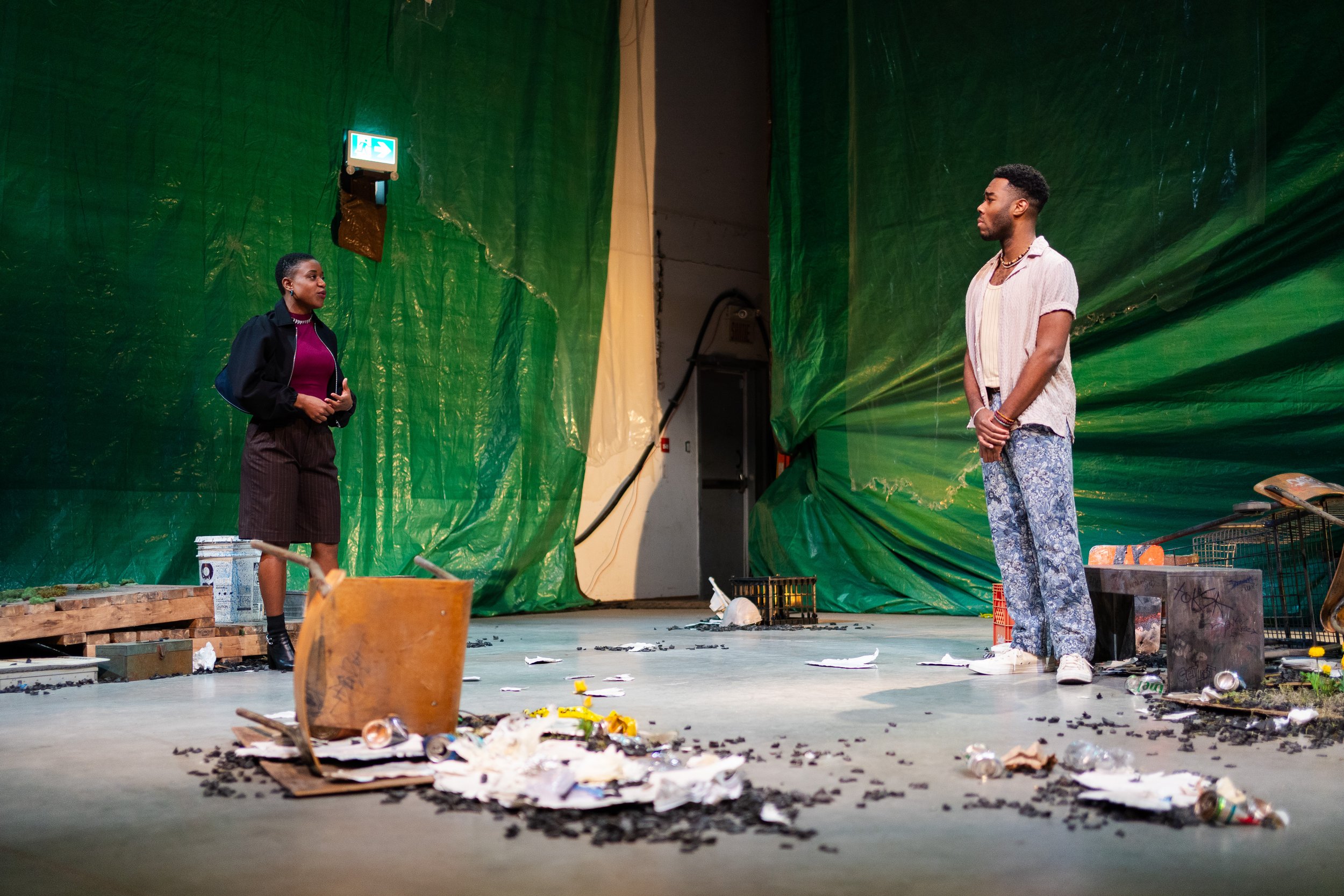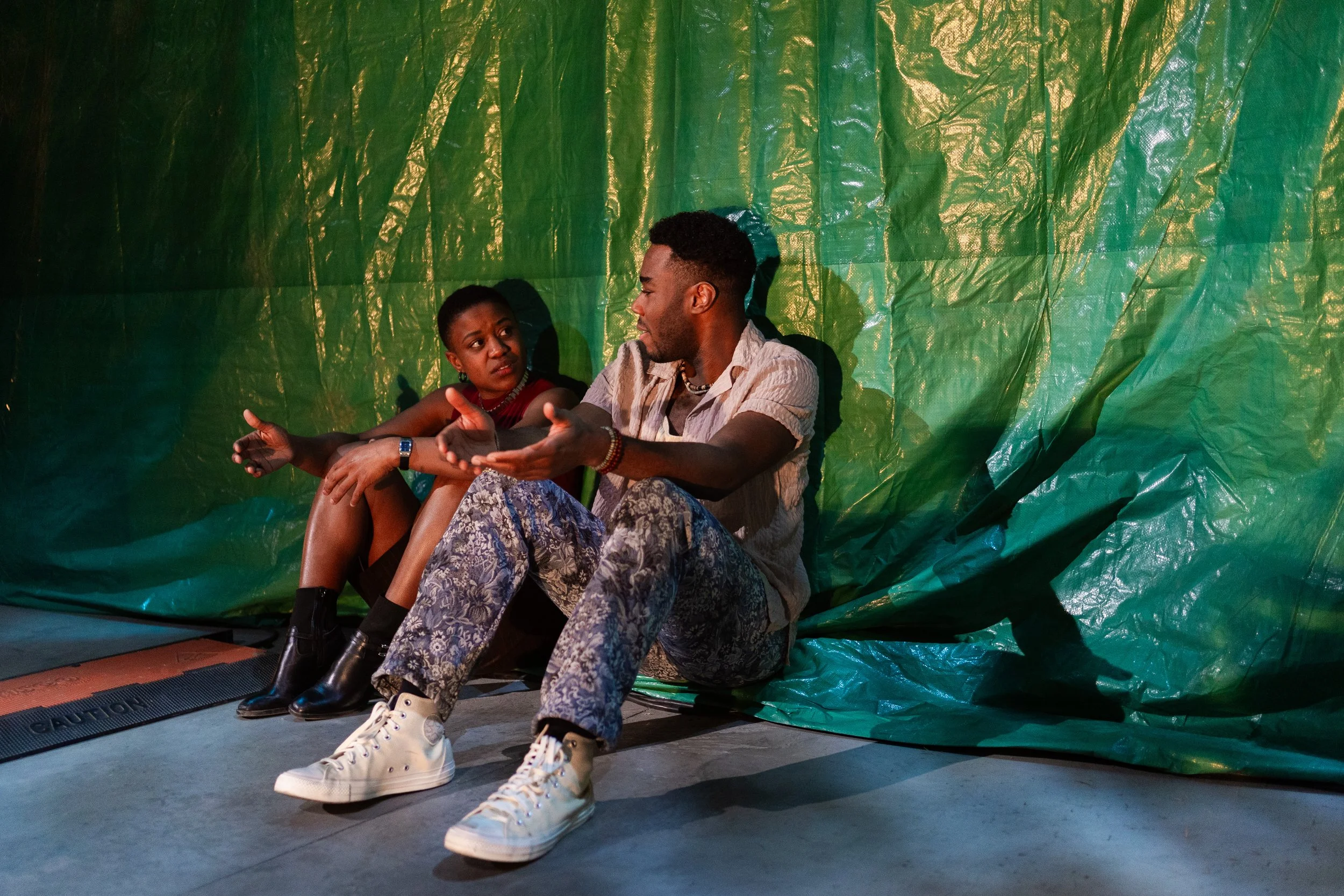Imago Theatre’s Scorpio Moon Review
Theatrical Convention vs. Immersive Ambition
Studio Mile-Ex, an expansive industrial space in the rapidly evolving Mile-Ex neighborhood of Montreal, served as the setting for Imago Theatre’s “immersive and site-specific” Scorpio Moon. Once our tickets were scanned, we passed through a door, then a passage lined with plastic sheeting and tarps, entering the world of the play.
The space itself, with its concrete floors and exposed ceiling beams held a certain authentic, industrial potential, a blank canvas for immersive world-building. However, this potential was immediately undermined by the rigid and uncomfortable tiered seating facing a clearly defined stage, a spatial contradiction that betrayed the production’s ambitions. The atmosphere was one of strained artifice, a clash between the venue’s inherent authenticity, and the production’s misguided theatricality.
A dramatic two-hander always appeals to me, so Adjani Poirier’s Scorpio Moon, a play exploring the complexities of a fractured relationship between characters Lily and Koa in the aftermath of a profound betrayal, held the promise of an intense, character-driven drama. Set against the backdrop of a city with low rent and high culture, the production aimed to delve into themes of race, queerness, art, and economic pressures. However, the narrative’s execution fell woefully short of its ambitious thematic goals, marred by, among other things, underdeveloped characters and repetitive dialogue.
The play’s description, a dramatic exploration of fractured intimacy within an immersive, site-specific setting, piqued my interest. As both a practitioner and theorist of immersive theatre, with years of experience creating large-scale experiences, and a recently published manifesto on my Strategies of Immersion, I approached Scorpio Moon with a hopeful, but discerning eye. The immediate disconnect between the venue’s raw potential and the production’s traditional staging signaled a fundamental lack of understanding of the form.
As a young professional actor, my first immersive production came between the ages of eight and ten, as I was involved in a sophisticated walk-through experience produced by a theatre company in Detroit. That left an indelible mark on my creative soul, and while I took the long way, I’m thrilled to now find myself creating large, innovative immersive productions. All this to say: I can speak to the work. And while Scorpio Moon’s creative team was accurate when describing a site-specific theatre piece, they were overzealous and misguided when referring to the play as “immersive”.
Photo by Emelia Hellman
Stavri Papadopoulou’s set, while figuratively reflecting the abandoned warehouse setting, was a masterclass in missed opportunities. The meticulously arranged detritus, items like rocks, milk crates, plastic buckets, and a shopping cart, rather than becoming interactive elements, remained mostly static, sterile objects, touched once or twice at best. In immersive work, the environment is a dynamic, living entity, constantly shifting and changing in response to the performers and the audience. This set, in contrast, felt like a museum display, untouched and detached from the narrative itself. Even the beat-up shopping cart looked like it had been purchased from a store the previous day. The set design was clean, untouched, and antithetical to the piece.
The lighting design by Aurora Torok, while technically proficient, was a glaring example of theatrical convention undermining immersive intent. Stage lights confusingly placed amongst the garbage piles on the set served as a constant reminder of the construct, disrupting any sense of naturalism or immersion. The actors, bathed in theatrical light against the dark backdrop, were performers on a stage, not inhabitants of a fully realized world. When crafting immersive experiences, one must transcend pedestrian lighting choices, moving beyond typical theatrical practices. In the dark warehouse, the two characters remained perfectly lit for the duration of the piece, with any and all dramatic moments literally undershadowed by the out-of-place design.
The soundscape, an inconsistent and jarring mix of diegetic and non-diegetic sound, was a frustrating distraction at best. Distant bass music and the wail of sirens, along with moody and seemingly arbitrary musical interludes, drew focus from the intimate story, highlighting the production’s lack of cohesive vision.
Adjani Poirier’s script, while ambitious in its thematic scope, struggled with underdeveloped characters and repetitive dialogue. The first two acts, washed with forced exposition, actually expanded the liminal space between the characters and the audience. The characters were perpetually explaining things to each other that should be known, would be known, to friends of 10 years. The play’s thematic pillars felt superficial, failing to resonate with genuine emotional impact, and the characters’ relationship lacked a sense of organic connection and authenticity. The story is repetitive, with the major points of conflict being addressed, and readdressed, in each act, without any movement toward resolution. I wondered many times throughout the production what the characters, Lily and Koa, were trying to salvage, as they didn’t even appear to like each other. In what can only be described as self-awareness, the script relies heavily on being mean for the sake of being mean, prompting the only reactions from the audience I heard on the night I attended. The third act of the production, however, genuinely showcases Poirier’s skill as a writer, and where their attention was most focused while creating Scorpio Moon. In fact, the play would have been better served with a rearrangement, starting with the third act and working backward. These are problems easily addressed in the workshop process. It’s credited in the program that the play’s development was assisted by Playwright’s Workshop Montreal. This isn’t the first struggling production I’ve seen fostered by the organization, and I find myself once again wondering, what exactly does PWM do?
To be clear, the script is not bad. The script is simply underdeveloped. The inspiring themes were superficial at best, or entirely absent. But Adjani Poirier took a big swing, and is definitely a playwright whose career is worth watching. I look forward to what she does next.
Photo by Emelia Hellman
The directing, attributed to two individuals (Murdoch Schon, as director, and Warona Setshwaelo, as associate director), felt largely absent, leaving the actors adrift in the space. The first 20 minutes of the piece had the characters circling each other in a five-foot-square space, using none of the massive abandoned warehouse set. The glaring lack of chemistry and familiarity between the actors indicated a failure to establish compelling dynamics. In immersive work, the actors’ connection to the space, and each other, is paramount, however, Lily and Koa both seemed very unsure of their physical placement. As a director, I have both learned, and developed my own methods of increasing familiarity between characters. With my production Who’s Afraid, another dramatic two-hander, the characters were a couple, together for five years. This had to seem natural, and it did. So much so, audience members often thought the relationship itself was real. Regardless of your approach to directing, creating a deep familiarity between characters is a challenge, but an attainable goal. It may have been due to a limited rehearsal process, or too many people involved (two directors is one too many), but Lily and Koa spent the production speaking as though they’d never met. Whether it was poor choices (an actor facing away from the audience for 15 minutes isn’t immersive, it’s just bad blocking), an inability to properly utilize the space, or the uncomfortable lack of a believable relationship between the characters, the directing of Scorpio Moon was a missed opportunity.
Bénédicte Bélizaire, as Lily, delivered a performance that transcended the production’s limitations. Her moments of emotional honesty offered a contrast to the overall vapid nature of the piece. Cameron Grant’s portrayal of Koa, however, felt academic, lacking authenticity. The actors knew their lines, but the characters felt unfamiliar to them, and to each other. Bélizaire was a clear standout, at times carrying the production on her shoulders, providing some of them only moments of true connection with the text, and with the audience. This is particularly important in the face of Cameron Grant’s perpetual smirk, and his character’s (or the actor’s) unwavering smugness. In contrast to Bélizaire’s more natural delivery, I found Grant’s performance to be marinated in theatre voice (an unemotional, repetitive, and rhythmic delivery akin to poetry voice), often forcing the production into the realm of high school theatre.
Ultimately, Scorpio Moon ignored the site-specific nature of the piece, and fell well short of its immersive potential, remaining firmly rooted in conventional theatrical staging. While Adjani Poirier’s script holds promise, the production’s directorial and performance choices hindered its overall impact. I would recommend this piece to those interested in witnessing the early work of a rising playwright, with the caveat that the immersive claims should be approached with caution.
Scorpio Moon is currently running at Studio Mile-Ex until Sunday, April 6th. For more information and tickets, visit the Imago Theatre website.





